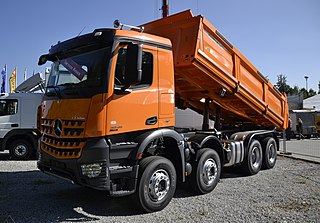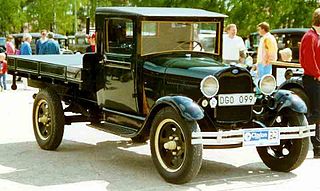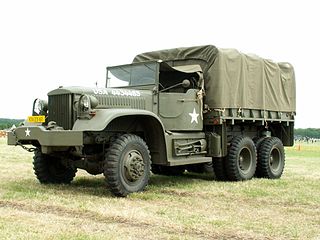
Rail terminology is a form of technical terminology. The difference between the American term railroad and the international term railway is the most significant difference in rail terminology. There are also others, due to the parallel development of rail transport systems in different parts of the world.

A trailer is an unpowered vehicle towed by a powered vehicle. It is commonly used for the transport of goods and materials.

This is a glossary of the components found on typical steam locomotives.

A dump truck, known also as a dumper truck or tipper truck, is used for transporting dumps for construction as well as coal. A typical dump truck is equipped with an open-box bed, which is hinged at the rear and equipped with hydraulic rams to lift the front, allowing the material in the bed to be deposited ("dumped") on the ground behind the truck at the site of delivery. In the UK, Australia, South Africa and India the term applies to off-road construction plant only, and the road vehicle is known as a tipper lorry, tip-truck, tip-trailer, tipper truck, or tipper.

The GMC Motorhome was manufactured by the GMC Truck & Coach Division of General Motors for model years 1973–1978 in Pontiac, Michigan, USA — as the only complete motorhome built by a major auto/truck manufacturer. Manufactured in 23 and 26 ft lengths, the design was noted for its front-wheel drive and its low profile, fully integrated body.

The Hotchkiss drive is a shaft drive form of power transmission. It was the dominant means for front-engine, rear-wheel drive layout cars in the 20th century. The name comes from the French automobile manufacturer Hotchkiss, although other makers, such as Peerless, used similar systems before Hotchkiss.

The Studebaker US6 (G630) was a series of 2 1⁄2-ton 6×6 and 5-ton 6×4 trucks manufactured by the Studebaker Corporation and REO Motor Car Company during World War II. The basic cargo version was designed to transport a 5,000 lb (2,300 kg) cargo load over any type of terrain in any weather. Most of these were exported to the Soviet Union under Lend-Lease by the USA during World War II, since the competing GMC 6×6 CCKW design proved to be more suitable for Western Front conditions.

The Ford Super Duty is a series of trucks manufactured by the Ford Motor Company. Introduced in 1998 for the 1999 model year, the F-Series Super Duty trucks marked the addition of a heavy-duty pickup to the Ford F-Series range with the new versions of the F-250, F-350, and F-450 trucks, while the previous 1987–1997 F-Super Duty chassis cabs were replaced by the F-450 chassis cab and F-550 Super Duty.

Galloping Goose is the popular name given to a series of seven railcars, built in the 1930s by the Rio Grande Southern Railroad (RGS) and operated until the end of service on the line in the early 1950s. They were derived from full-sized automobiles.

The Ghost Town & Calico Railroad is a 3 ft narrow-gauge heritage railroad and amusement park attraction within Knott's Berry Farm, an amusement park located in Buena Park, California.

Ford Model AA is a truck from Ford. As the Model T and TT became obsolete and needed to be replaced, Henry Ford began initial designs on the Model A and Model AA in 1926. Basic chassis layout was done rapidly and mechanical development was moved forward quickly. Body design and style was developed and then outsourced to various body manufacturers, including Briggs and Murray. The designs of the Model A shared parts and materials with the Model AA Ford, notably the body, engine and interior. The AA usually received plainer interiors than their car counterparts. The Model AA followed similar design changes to the Model A during the AA's four years in production, often delayed anywhere from three to nine months. The mechanical changes and upgrades were done during production of the vehicles. Body changes that occurred between 1929 and 1930 were also integrated into AA production, but leftover parts were used longer in the heavy commercial trucks.
The Diamond T Company was an American automobile and truck manufacturer. They produced commercial and military trucks.

The Meillerwagen was a German World War II trailer used to transport a V-2 rocket from the 'transloading point' of the Technical Troop Area to the launching point, to erect the missile on the Brennstand, and to act as the service gantry for fuelling and launch preparation.

The Ninth Generation Ford F-Series is a line of full-size and medium-duty commercial trucks that were produced by Ford from 1991 to 1997. While still based on the basic design dating from for the 1980 model year, the 1992 F-Series brought a number of minor changes to the exterior and interior. This is the last generation of the F-Series that was produced as a complete range of trucks from a half-ton pickup to a medium-duty Class 6 truck. As this generation was replaced during the 1997–1998 model years, the larger models of the F-Series were split from the F-150; these became the Ford Super Duty trucks, related to the latter with a few powertrain components.
The Austin 15-20 is the smaller-engined of the almost identical pair of new cars announced by Herbert Austin in February 1906. A very complete catalogue with detailed specifications was issued at the same time. As well as the engine's smaller bore the 15-20 differed from the 25-30 by being only available with a live rear axle and not chain-drive. Otherwise the specifications were the same, the very minor differences are detailed below.

The 6-ton 6×6 truck was a family of heavy tactical trucks built for the United States Army during World War II. The basic cargo version was designed to transport a 6-ton (5,400 kg) cargo load over all terrain in all weather. The chassis were built by Brockway Motor Company, The Corbitt Company, The Four Wheel Drive Auto Company (FWD), Ward LaFrance Truck Corporation, and White Motor Company. They were replaced by the M39 series 5-ton 6x6 trucks in the 1950s.

Rio Grande Southern Railroad (RGS), Motor No. 2 is a gasoline engine-powered narrow gauge railroad motorcar. It was converted on August 12, 1931 from a 1927 Buick Master Six 4-door sedan. The Buick was cut behind the rear doorpost and extended with sheet metal 18 inches (46 cm) to form an enlarged passenger compartment. With no functional use, the steering column was removed. The couch from the RGS office become the back seat as it is shown being requisitioned for Goose No. 2 on the statement covering construction. The front axle was removed and replaced with a swiveling, two-axle lightweight railroad truck with 16 in (41 cm)-diameter wheels that carried and guided the front of the Goose. Ahead of the front truck the pilot is attached to the frame. There were two small pivoted scrapers attached to the rear of the pilot to keep small objects on the track from derailing the lightweight front truck. During the winter season a small snowplow was attached to the front of the pilot.

The Diamond T 4-ton 6×6 truck was a heavy tactical truck built for the United States Army during World War II. Its G-number was G-509. Cargo models were designed to transport a 4-ton (3,600 kg) load over all terrain in all weather. There were also wrecker, dump, and other models. They were replaced by the M39 series 5-ton 6x6 trucks in the 1950s.

The Unimog 406 is a vehicle of the Unimog-series by Mercedes-Benz. A total of 37,069 units were manufactured by the Daimler-Benz AG in the Unimog plant in Gaggenau from 1963 to 1989. The 406 was the first medium duty Unimog, having a larger wheelbase of 2380 mm and more than twice the engine power of the Unimog 401. Unlike the initial Unimog, the 406 does not have a car engine but a heavy duty truck engine instead. Several following Unimog versions were based on the 406. There were eleven different types made of the Unimog 406, which were available in four models with a closed two-door or four-door cab, as Cabrio and as an OEM part. During its long production period, the 406 received several technical refinements. In 1964, the precombustion chamber diesel engine OM 312 was replaced with the direct injected OM 352. Disc brakes followed in 1973. For many enthusiasts, the Unimog 406 represents the classical Unimog, having agricultural and silvicultural applications. It was successful and the best embodiment of the word Universal-Motor-Gerät considering all prior Unimogs.



















